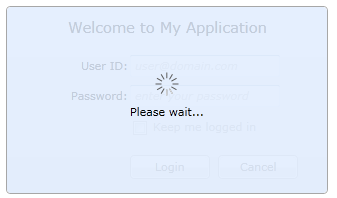

| Intersoft.Client.UI.Controls Namespace > UXBusyIndicator Class : OverlayBackground Property |
<CategoryAttribute("Brushes")> Public Property OverlayBackground As Brush
Dim instance As UXBusyIndicator Dim value As Brush instance.OverlayBackground = value value = instance.OverlayBackground
[CategoryAttribute("Brushes")] public Brush OverlayBackground {get; set;}
[CategoryAttribute("Brushes")] public: property Brush^ OverlayBackground { Brush^ get(); void set ( Brush^ value); }
One of the useful features in UXBusyIndicator is the ability to block the content from user interaction when the control is in busy state. This feature is enabled by default, which can be disabled by setting the BlockUIOnBusy property to false.
When enabled, UXBusyIndicator automatically disable the content and show an overlay on the top of the content which gives impression to users that the content cannot be accessed.
The overlay is set to a semi-transparent radial gradient background which is ideal for typical business applications. You can easily customize the background brush by setting the OverlayBackground property. In addition, you can provide more comprehensive styling to the overlay element by specifying a style to the OverlayStyle property.
The following illustration shows the UXBusyIndicator with a customized overlay background.

Target Platforms: Windows 7, Windows Vista SP1 or later, Windows XP SP3, Windows Server 2008 (Server Core not supported), Windows Server 2008 R2 (Server Core supported with SP1 or later), Windows Server 2003 SP2